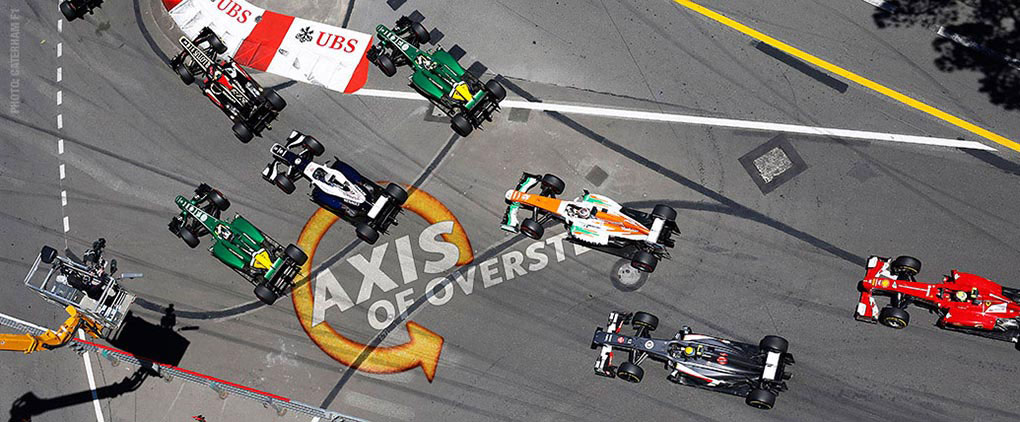Pin It
The repeated postponing of the Nascar Daytona 500 due to weather this week, along with a good bit of public
New rubber compounds and computer designed tread patterns have made it possible to design road car tires which are quite safe to drive in the rain at speeds 1960's NASA scientists might not have believed possible.
 At high speed, the name of the game is water elimination and a modern road car tire will expell about 13 liters /3.5 gallons of water per second.
At high speed, the name of the game is water elimination and a modern road car tire will expell about 13 liters /3.5 gallons of water per second.The ultimate expression of wet weather tire of the moment, the Pirelli Cinturato Formula 1 will expel about 60 liters /16 gallons of water per second at 300km/h. To put it another way, on a minute and a half lap, say at a high speed track like Silverstone, a single Formula One car traveling at an average speed of 200 km/h will pump something in the order of 14,000 liters / 3700 gallons of water per lap. Mind boggling.
But even that is not always enough. Water, like in the 1960's still cannot be compressed, and when the water gets deeper than the tread blocks, like in Montreal in 2011, you just have to park it.
That's rare, the more typical occurrence is that track conditions change during a race, making spectators happy and tire engineers and strategist earn their keep.
Martin Brundle explains what Axis readers probably already know...
Not just F1 of course, every racing series (except for NASCAR) races in the rain with reasonable safety, including at Daytona...
We all benefit from trickle down and today's top brands can produce tires that are quite amazing. Last year, at the One Lap of America we scored a .825G side load on the wet skidpad using off the shelf road car rubber, not an exciting video but a figure that would have certainly impressed those 1960's NASA engineers!

Are there other racing series that race in the rain on oval tracks?
ReplyDeleteTo be honest , I don't think it's technically feasible to make a rain tire that would work for Oval racing but NASCAR will not race in the rain even on road courses and that's lame.
DeleteNASCAR used to have rain tires for road courses. I believe they raced in the rain at Suzuka in 1997. As far as I know, it never rained in the US for them to use the tires during a race. I am not sure why they no longer have them.
DeleteNASCAR's junior series raced in the wet in Montreal two or three seasons ago. It was, interesting.
DeleteAfter watching the Brundle tire video, i vote that F1 starts running wet tires ONLY! Much more exciting :P
ReplyDeleteI really liked this post.
ReplyDeleteHonestly, people can argue all they want about the physics involved, but as far as I've seen there is no empirical evidence to support these opinions. I HATE Nascar. Having said that, I would absolutely love to watch them run in the rain.
Given the tire technology available these days theres no reason. For the people saying "it can't be done" :
Can anyone provide hard evidence as to why? Is there a video out there somewhere? Data? Driver testimonials? Anything?
I think the fact they won't run in the rain on road courses is hinting to something more than the "it's dangerous / tires / spray " counter arguments...
In little old NZ, we have a road safety campaign: "drive to the conditions". Drive as fast as you think you can. May the best skilled driver win.
ReplyDeleteNot to defend the roundy-rounders, but does a big banked oval like Daytona present special problems in terms of the amount of water cascading from the top of the banking to the bottom across the direction of travel? I raced motorcycles at Daytona in the 1970s and during one practice the skies opened up. A friend was out on the track, far from the pits, and he rode up the banking and stopped in the lee of the outside wall. (Don't ask me why.) The downpour washed him off the banking and he and the bike slid to the apron.
ReplyDeleteIt could be argued that a banked track would have no standing water like a level road course, but would the stream of water crossing it make a difference?
I think this is a reasonable question. I'm not a ROUNDY ROUNDER either, but I live an hour away from Daytona, and have both ridden, at speed, and driven on that track, (NOT in a RACE). The banking is unfathomable, if you haven't actually been on it. I got the chance to walk up from bottom to top of NASCAR 3, and I can tell you, it is STEEP! Here, in Florida, rain usually comes in two qualntities, tons or deluge. I'm not sure any tire, or their presecribed width could handle one of those behemoths, at 100 mph, buch less 200. That said, they only have five super speedway races, 2 at Talledega and 3 at Daytona. There could be a reasonable exception, I'd think.
DeleteThere would be zero visibility when racing on an oval in the rain -- especially with 43 cars going at once. It would be stupid and dangerous.
ReplyDeleteAs for why NASCAR no longer has rain tires for road course, I don't know. They did for many years until 2005 or so, but it never rained (except at Suzuka that I know of), so they were never used.
Totally unique stuff is here really amazing!!!
ReplyDeletecheap winter tyres